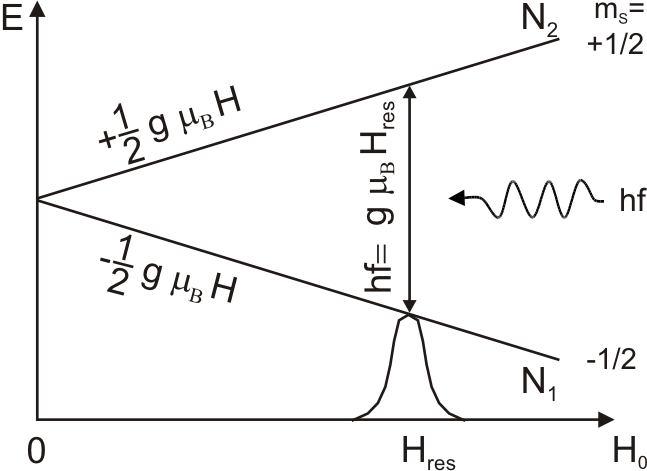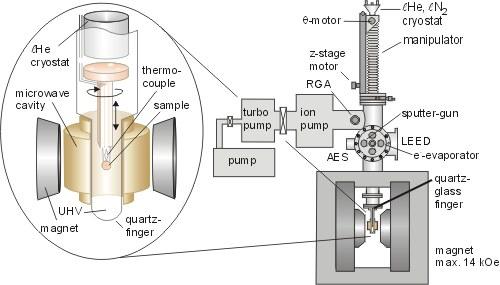Ferromagnetic Resonance (FMR)
 FMR is a method to measure magnetic properties by detecting the precessional motion of the magnetization in a ferromagnetic sample. It is thus related to the electron paramagnetic resonance technique. From a macroscopic point of view, the applied static magnetic field H0 causes the total magnetic moment to precess around the direction of the local field Heff, before relaxation processes damp this precession and the magnetization aligns with Heff. If the sample is irradiated with a transverse rf field (microwaves of typically 1–35 GHz), and if the rf frequency coincides with the precessional frequency, the resonance condition is fulfilled and the microwave power is absorbed by the sample. The motion of the magnetization is described by the Landau-Lifshitz-Gilbert equation:
FMR is a method to measure magnetic properties by detecting the precessional motion of the magnetization in a ferromagnetic sample. It is thus related to the electron paramagnetic resonance technique. From a macroscopic point of view, the applied static magnetic field H0 causes the total magnetic moment to precess around the direction of the local field Heff, before relaxation processes damp this precession and the magnetization aligns with Heff. If the sample is irradiated with a transverse rf field (microwaves of typically 1–35 GHz), and if the rf frequency coincides with the precessional frequency, the resonance condition is fulfilled and the microwave power is absorbed by the sample. The motion of the magnetization is described by the Landau-Lifshitz-Gilbert equation:

 The green part corresponds to the precession. The yellow part introduces a viscous damping (Gilbert damping constant G). The effective magnetic field Heff includes the applied DC field, the rf microwave magnetic field component, the demagnetizing field (shape anisotropy) and the magnetocrystalline anisotropy field. γ is the gyromagnetic ratio γ =gµB/ħ.
The green part corresponds to the precession. The yellow part introduces a viscous damping (Gilbert damping constant G). The effective magnetic field Heff includes the applied DC field, the rf microwave magnetic field component, the demagnetizing field (shape anisotropy) and the magnetocrystalline anisotropy field. γ is the gyromagnetic ratio γ =gµB/ħ.
Microscopically, the H field creates a Zeeman splitting of the energy levels, and the microwave excites magnetic dipole transitions between these split levels. Since it is difficult to vary the microwave frequency over larger ranges, the DC magnetic field H0 is varied instead.
 Usually the absorption derivative is measured. The resonance signal resembles a Lorentzian lineshape. The resonance field position Hres depends on the angles, anisotropy parameters, g-factor, and magnetization of the sample.
Usually the absorption derivative is measured. The resonance signal resembles a Lorentzian lineshape. The resonance field position Hres depends on the angles, anisotropy parameters, g-factor, and magnetization of the sample.
The linewidth ΔH is directly connected to the relaxation processes. In ultrathin films, Gilbert damping is commonly used to describe the relaxation. But several other possible relaxation paths are also known, e.g. two-magnon scattering, spin-pumping effect, etc., which can contribute to the linewidth.
 The anisotropy constants can be easily deduced from angle dependent measurements of single crystalline samples. For magnetic multilayers, also the interlayer exchange coupling constant can be determined by FMR in absolute units.
The anisotropy constants can be easily deduced from angle dependent measurements of single crystalline samples. For magnetic multilayers, also the interlayer exchange coupling constant can be determined by FMR in absolute units.
The sample is kept under UHV inside a quartz glass finger connected to the UHV chamber. It fits into the microwave cavity. The microwave components and the electromagnet coils are outside the vacuum and therefore conveniently accessible or removable. Thus, the samples can be stepwise prepared and measured in situ under UHV consitions. Especially for magnetic multilayers this is an advantage over conventional FMR set-ups.
